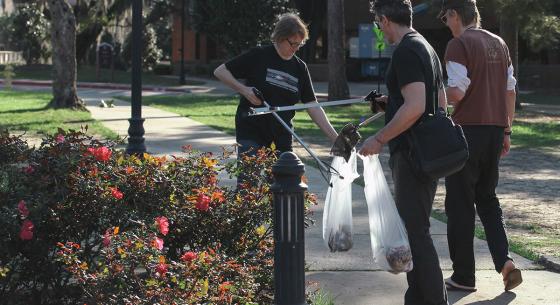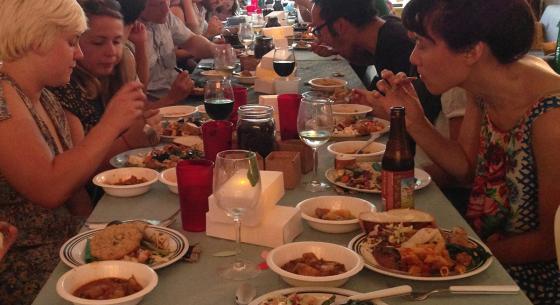Creating a Community Around SHORE: Part 2
Editor's Note: Today, we're back with the second of two blog posts of interview questions from Emily Johnson; find the first installment here. Emily Johnson is an artist close to Northrop's heart. SHORE, her third performance in a trilogy of works, is being presented by Northrop next week. For full details of the performance, go here. For an even deeper look at this artist's work, enjoy the below interview with Emily Johnson.
6.) Storytelling has been such an important part of the whole trilogy—stories told in so many different ways—and now, in SHORE, you present us with something called "Silent Story"—how did that come about?
I’ve always thought about the stories in each of our bodies—the stories we remember and know and also the stories that are somehow passed on and live in our bodies without words. I want to honor all of these stories that are in each of us. What we call ‘silent story’ isn’t about showing anything at all—it’s about sharing a vulnerable state, a joyful or grief-ful moment. We—Krista Langberg, Aretha Aoki, and I are creating stories in our minds and you see the effort of that. The stories are shared in that moment …you see us live a moment, we share that moment with you. It’s different for each of us. For me, it’s emotional and it’s not ‘performed’ at all. It’s real—it’s a real story. And it’s always different, always a new story—every rehearsal, every performance—each one of us is thinking a story that we haven’t thought before.
7.) Each part of the trilogy has had its own “signature” musical instrument and sound—the pedal steel guitar for The Thank-you Bar, the violin for Niicugni, and now the human voice in SHORE. What has been the significance behind each of these instruments?
The pedal steel guitar, to me, is memory. My grandma’s bar had a jukebox which was playing pretty much all the time. The classic country standards on it were the sounds and songs of my childhood, and pedal steel is the sound of those songs, that era. Joel Pickard (our collaborator in The Thank-you Bar) had been experimenting with deconstructing country standards, which was the perfect sound and context for the reframing, reconstruction, deconstruction, and creation of new memory in The Thank-you Bar.
In Niicugni we needed a sound and instrument that could travel, from stage to house, to lobby, and back. I knew I wanted strings. I wanted that sound and I wanted to see the action of playing a violin. I was also influenced by the sewing of the lanterns—the imitation sinew, the string that sews the skins together…
For SHORE, we needed voice. SHORE is so much about sharing—stories, work, food—about everyone contributing, bringing something—and our voices are something we can share with each other, that we can connect to, relate to, encourage.
We envisioned a choir that sings outside and also in the theater. James and Nona Marie Invie composed the soundscore of SHORE, with Fletcher Barnhill, and we all wrote songs. I would hum something into my phone and send it to James and they would work with that. We created lyrics together and separately, we created songs and hums and chants. Nona sings. I’ve known Nona’s voice a lot longer than I have known Nona and I have wanted to work with her for so long. Her voice is resonantly deep like water—that’s just how I think of it—her voice is the voice of SHORE. It is the voice of a whale, perhaps, or a mother, or maybe all the mothers of the world. Yes, we needed voice.
8.) How did you come to work with Ain Gordon as Director? Is this the first time you’ve worked with an outside director?
Ain Gordon and I work together with SO Percussion, a percussion ensemble in New York. And I wanted to work with him on SHORE. We have a similar sensibility - similar loves and dislikes. I guess that lays a framework for a certain understanding….he is watching everything happening in the performance part of SHORE so intently. He is making us all be very, very present, which is what this work requires. He is helping me unearth the details. There is a casual and attentive nature to all of the action in SHORE and that requires a ton of rigor from us as performers, from us as makers. Ain is making us find that again and again. He is helping me find the wholeness of SHORE in each moment. I think of looking at an ocean—how you can see the vastness of it, but you can also hone in and see one whitecap on the tip of one wave—it’s like that for the work on stage, we have to make it so you can see it all and at the same time you can see each detail.
9.) What significance does the title SHORE carry for you, in representing this piece of work?
Shores are vital places. They are places where we do meet—people, animals, land, water. They are places where we have always met. They are a container. They are fluid. They are always shifting. It is also action, to shore up. To prepare. It is place and action at once.
My friend Ben Weaver (who is in SHORE and is also guiding the free bike ride to the FEAST) sent me a definition of SHORE from the amazing book Home Ground that says…”A shore, then, is the ultimate boundary between two worlds.” I like thinking of the many worlds within the world—the worlds different spaces and minds and bodies inhabit—and the ultimate connection between worlds that is possible.
10.) Because your work focuses heavily on the connection with space and environment, can you tell us what impact you want SHORE, as well as this trilogy of works as a whole, to have on both communities and our world?
I mentioned it above—I want us to take more time with and for each other and the world. I want us to relish gathering together. I want us to give attention and energy to the world and to each other. I want us to see performance as a vital part of this, as a vital part of understanding and paying attention to the world and all of the stories in it.
11.) Anything else you’d like to tell us about SHORE?
Yes—that in addition to the incredible artists who are working with me on SHORE, there are nineteen community partners who have been part of the development of SHORE! I am thrilled and very honored to have developed this project with this varied, intentional, super involved group of partners and extraordinary people. Especially Native American Community Development Institute and All My Relations Gallery, Red Stag Supper Club, Foxtail Farm, Minneapolis Parks, The Loft, Dream of Wild Health, Birchbark Books, RiverLife, The Cornerstone Group, and Institute for Advanced Study—the people at these organizations and businesses are so awesome and we built something together that is quite extraordinary—that is a full affirmation of art and life combined, that is complex and simple simultaneously. It has been no small bit of work to make SHORE—it has taken all these committed people and partners, artists and community members. I feel the care that has gone into making SHORE happen and I am thrilled for SHORE and that care to be given back to the world.



